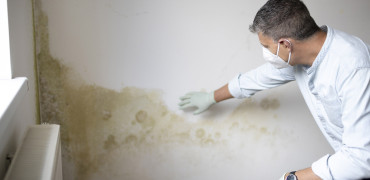This coming Wednesday 8th November is World Ventil8 Day, which aims to raise awareness of the importance of ventilation as a crucial part of enabling health and wellbeing of people.
World Ventil8 Day was created by BESA last year on the back of the pandemic when the importance of ventilation systems became apparent.
As ventilation is one of the key steps to tackling mould and damp, it also seems an opportune moment to highlight the benefits of a free guide from BESA on how to prevent mould occurring.
When we launched the guide earlier this year, I was asked whether we could come up with a ‘sexier’ title than ‘Mould and damp prevention in new and existing homes’, as this would help ‘sell’ the guide and help it reach a wider audience.
But there literally is nothing ‘attractive’ about mould and I personally think the guide stands up by itself without the need for spin or embellishment.
The guide has been created to show the practical steps that homeowners, landlords and social housing providers can do to reduce the chances of damp and mould appearing in homes – something that will regularly happen in the cold, moist atmosphere we have quite a lot here in the UK.
The NHS spends £1.4 billion annually on treating illnesses associated with damp housing
Serious health risks
The death of two-year-old Awaab Ishak in a Rochdale Boroughwide Housing flat brought the health hazards of mould to national headlines in 2022.
Unfortunately, this is not an isolated story.
Damp and mouldy homes are a cost to all of us, whatever the conditions of your own home. The NHS is estimated to spend £1.4 billion annually on treating illnesses associated with cold or damp housing.
The World Health Organisation (WHO) believes that mould is so dangerous that it doesn’t recommend setting minimum ‘safe’ levels. Instead, WHO advises that damp and mould should be prevented, and if they do occur, they should be dealt with immediately.
The silent hazards in our homes
It’s usually easy to spot when a home has a mould problem, although some types of mould are not visible. Typically, it appears as a dark stain or black growth around windowsills, walls and ceilings.
But mould doesn’t just look unsightly - it’s also bad for your health, and for some people, it can be deadly. Once mould spores are airborne, they can be inhaled, causing respiratory infections and long-term illnesses.
In the foreword to the guide, writer, TV presenter and architect, George Clarke says: “A home should be a place where we feel safe, happy and healthy. But that’s not the case for some families whose flats and houses are riddled with damp and mould.”
The combination of damp and mould can cause various physical symptoms from itchy skin to deadly lung disease.
Perhaps even more insidious though, is that living in these conditions is known to impact mental health, causing depression and anxiety.
What is mould?
Mould is a microscopic fungus resulting from two ingredients: damp and microbes. WHO says that once damp builds up, the dust and dirt in most indoor spaces provide sufficient nutrients to start mould fungus developing and growing.
There are hundreds of species of mould spores potentially in the air in our homes, many of them entering from the outside but often produced indoors.
Mould fungus breaks down dead organic materials found in carpets and even wallpaper. It can also build up in spaces where air does not circulate very much, for example, behind wardrobes or in cupboards, so it’s important to air these spaces regularly.
Because of this, even in the cleanest home, the potential for mould is always there once excess moisture becomes a factor.
And when mould grows, it emits more spores into indoor air. So, the problem multiplies quickly and without proper intervention, it almost always gets worse.
Why do homes become damp?
Damp in a home can be caused by several factors. Some of these can be structural, for example, leaking pipes or rain seeping through a roof. Rising damp can also be a problem where a damp course has been breached, for example, if the ground level around the house has been raised above the existing damp course for a patio or extension.
Unfortunately, dampness is also caused by everyday home activities such as bathing and showering, cooking on the stove or drying clothes on a rack. Even sleeping occupants in bedrooms exhale moisture.
The water vapour from these daily routines can collect on cold surfaces such as walls, windows and sills - this is known as condensation.
Condensation forms on walls and other surfaces more quickly when it’s cold indoors. So, using the heating less in cold weather can lead to more problems with long-term damp conditions.
What’s more, excessive indoor moisture makes a house feel colder and humid walls lead to a coldness that makes more heating necessary, increasing energy bills.
Recommended steps
Most people’s first instinct when dealing with mould is to clean it away. But although it’s possible to scrub mould from walls and tiles, this is only a temporary solution unless more is done to stop it returning.
Painting over the mould is also ineffective in the long term.
Getting rid of mould permanently means removing the conditions that encourage it to grow. There are four recommended steps for tackling damp and mould - and making sure they don’t return.
- Step 1: Tackle sources of dampness around the building
- Step 2: Improve ventilation
- Step 3: Improve heating
- Step 4: Make a home that people can live in
Improving lives - preventing damp and mould
Good heating and ventilation are essential to healthy homes, but they must be affordable and useable for householders. The tragedy of high energy prices is that people turn off their heating, increasing the risk of damp and mould.
When the UK experienced high energy prices in 2022, it was reported that 25% of householders intended to leave the heating off because of problems paying higher energy bills. Not only do these householders face uncomfortable living conditions, but they are also more at risk of starting or adding to mould problems.
The good news is that we already have the tools to make the improvements that could save lives - and make these homes better places to live.
This guide from BESA and Mitsubishi Electric highlights how landlords and homeowners can tackle the problems of damp and mould at the source with straightforward steps to improve the indoor environment.
Please put 8th November into your annual diary to help broadcast the importance of World Ventil8 Day.
You can also watch me explaining more about the day on YouTube here.
Graeme Fox CEng MCIBSE F.Inst.R. is Director of Technical at BESA.



